Implementing Research-Based Learning Design in Edmentum Courseware

By Dr. Jayne C. Lammers, Director of Learning Design
At Edmentum, we regularly review learning sciences and education research to design with the latest findings in mind. This helps us ensure that our products deliver high quality learning acceleration for all students as knowledge about “what works” in the field evolves.
Our Learning Design team recently conducted a review of research to support an upcoming update of our Courseware Learning Design and Research Base. In this article, we share a preview into how research continues to inform our learning design principles while highlighting how we’ve been applying this research to recent Courseware development.
Edmentum Courseware Learning Design Principles
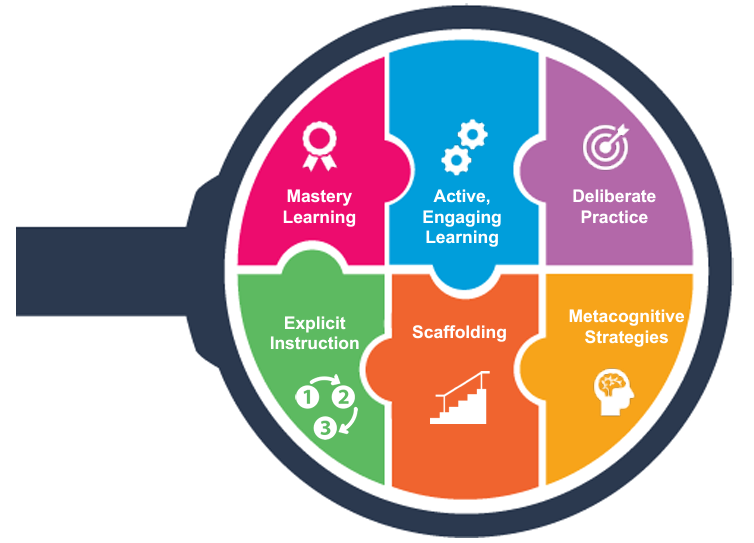
Edmentum Courseware’s learning methodology is rooted in six learning design principles that provide the bedrock for our development. Our review of recent research confirms that each principle maintains a sound basis in theory, best practice, and research.
Mastery Learning: Focus on efficient learning. Students show mastery of key content, invest time on not-yet mastered content, and proceed through learning new content at their own pace.
Active, Engaging Learning: Involve learners in responding to and manipulating information while they learn — ensuring their involvement in building understanding and minimizing passive reception of information.
Deliberate Practice: Offer intentional, structured, and sustained practice that builds thoughtfully in complexity to support increasing levels of understanding.
Explicit Instruction: Support successful learning by providing clear skill statements, modeling of learning outcomes, and reducing cognitive load.
Scaffolding: Buoy learning by providing specific supports when learners need them and systematically removing them—leading to independence as learners approach mastery.
Metacognitive Strategies: Engage students in reflecting on how they best learn and evaluating their thought processes to help themselves along their learning path.
Recent Research Informing Edmentum Courseware
Edmentum ensures the quality of our product design in part by learning from rigorous research shared in a variety of credible venues, including peer-reviewed academic journal articles and books from academic publishers. Below are five such sources included in our recent review, and for each, we offer examples of what the research looks like in the design of courses across the Courseware catalog.
1. Effect Sizes in Student Achievement Research
John Hattie updated his influential meta-analysis of evidence-based education research about student achievement, resulting in his 2023 publication of Visible Learning: The Sequel; A synthesis of over 2,100 meta-analyses relating to achievement. This book offers numerous implications for our design, given the breadth of the research he reviewed. Key insights we noted in this update to Hattie's work include the importance of:
- reducing the cognitive load for learners,
- providing detailed direct instruction, and
- including worked examples to enhance learners' understanding of concepts.
How Edmentum Applies this Research to the Design of Courseware
Edmentum course designers intentionally reduce the cognitive load for learners in various ways through explicit, direct instruction in all courses. Every Courseware lesson opens with one or more learning objective, ensuring learners and educators know the focus of attention for the lesson.

Figure 1. The new Web Technologies course for secondary students starts each tutorial with a clearly stated objective detailing what students can expect to learn.
New content is introduced in well-defined chunks and all courses are designed to include direct instruction when teaching new concepts and/or procedures. This includes explicit call out and defining of relevant academic vocabulary during course instruction. Here’s what this looks like in the Web Technologies course in our updated career and technical education (CTE) catalog.

Figure 2. Also in the Web Technologies course, students have relevant vocabulary called out and defined as new concepts get explained in each tutorial.
Edmentum Courseware supports learning by showing worked examples of key concepts. Students can self-pace through complex examples to reduce cognitive load and increase understanding. For example, all Mathematics courses include worked examples allowing learners to see the thinking processes involved in solving problems.
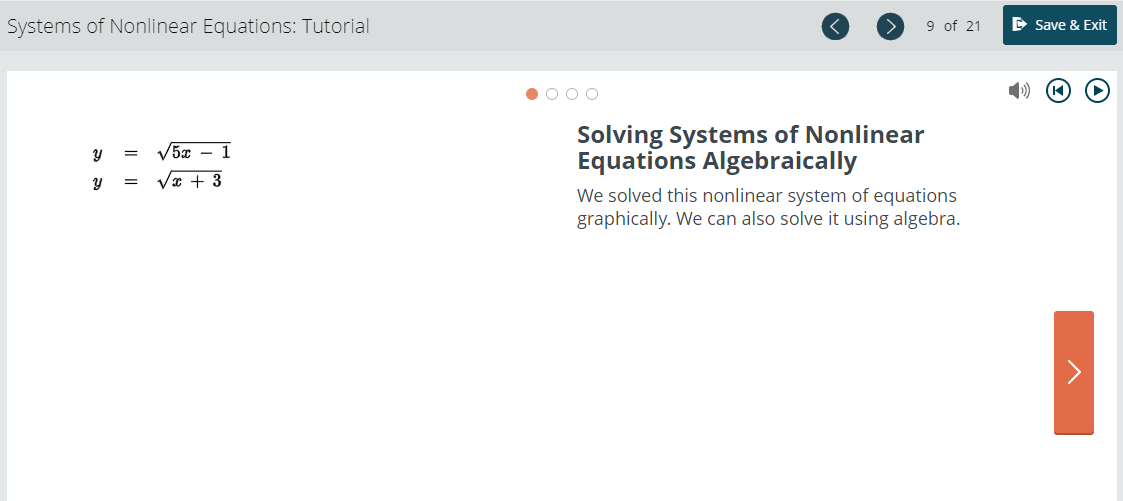
Figure 3a.

Figure 3b.

Figure 3c.

Figure 3d.
Figures 3a-d. In a recent update to the integrated Math 2 course for North Carolina, high school learners can go at their own pace through a worked example of how a nonlinear equation can be solved algebraically.
Our English courses also include worked examples for concepts being taught in the lesson. Here we see modeling of literary analysis and analyzing structures in informational texts.

Figure 4. In an English 9 tutorial, learners see a worked example of understanding a character’s perspective in literature.

Figure 5. In another English 9 tutorial, learners see a worked example analyzing the structural elements of an informational text and using highlighting to reduce the cognitive load for learners who can attend to the color-coding.
2. Comparing Active Learning with Passive Instruction
In another meta-analysis of 144 experimental or quasi-experimental studies capturing insights from more than 10,000 elementary, middle, and high school participants, researchers explored comparisons of an active learning treatment with groups who received traditional lecture-based instruction. Researchers found "that active learning is more effective on students' attitudes toward the course" and has the potential to "increase academic achievement" (Tutal & Yazar, 2022, p. 14), demonstrating the importance of including student-centered activities that engage learners with content in many different ways.
How Edmentum Applies this Research to the Design of Courseware

Figure 6. Direct instruction in a lesson in the 7th grade Science course, giving students relatable examples of systems.
Edmentum embeds a variety of active learning strategies throughout all Courseware courses to involve learners in responding to and manipulating information while they learn. Students receive regular zero-stakes opportunities to confirm their understanding during instruction. We see this in action in the self-checked activities and formative assessments students receive in a 7th grade Science course, for example. In this lesson, students learn how energy is transformed within a system, through direct instruction and a series of ungraded checks for understanding.

Figure 7. This is one of the zero-stakes checks for understanding that ask students to respond to and apply what they’re learning about to the roller coaster system in this self-checked activity.
In our Mathematics courses, students also get practice applying concepts to real-world situations as they learn. Here again, we see the roller coaster used as an example in the lesson, this time to help Algebra 2 students understand applications for the piecewise functions they are learning about.

Figure 8. In a version of Algebra 2 redesigned to align to the new Florida B.E.S.T. standards, students see how piecewise functions can be used to model real-world situations, like the path of a roller coaster.
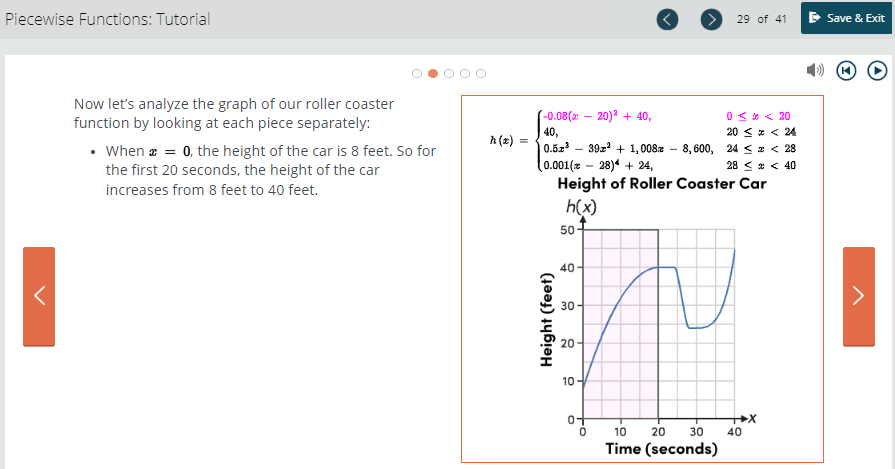
Figure 9a.

Figure 9b.

Figure 9c.

Figure 9d.
Figures 9a-d. Then, the next part of this lesson allows students to go at their own pace to analyze the graph of this function separately.
Students are then able to practice on their own, again in an ungraded activity that asks them to apply their learning about piecewise functions to a different real-world scenario and they receive optional additional supports in the form of a worked example with yet another application of these functions. All of which helps students engage more actively and see multiple applications of what they are learning.
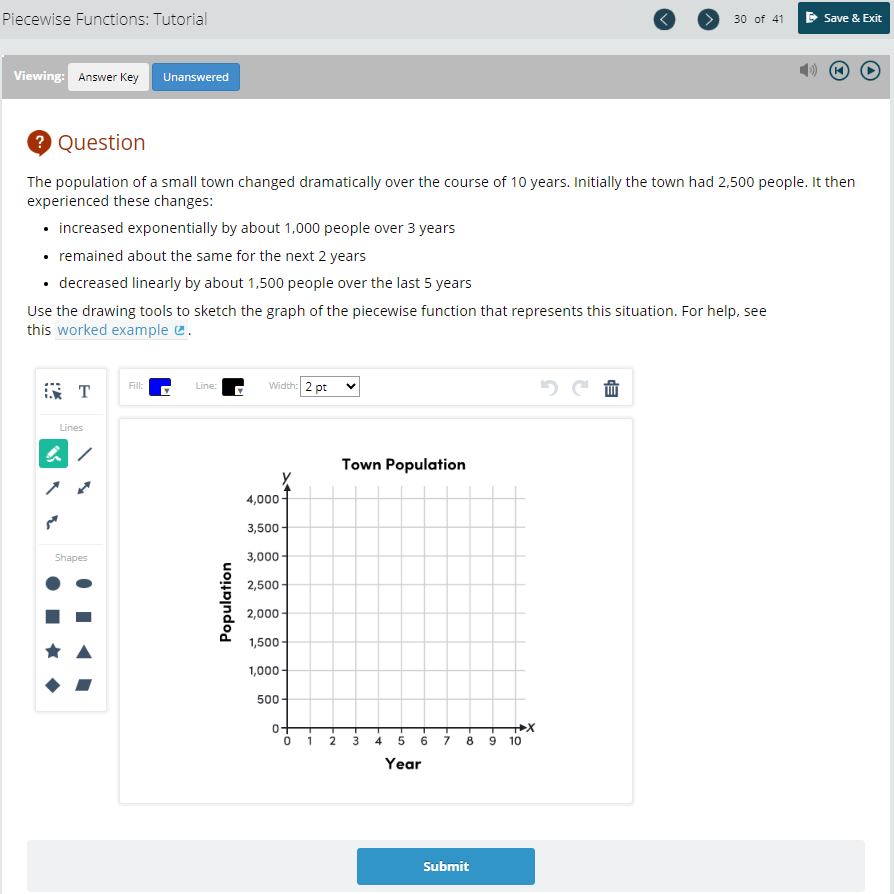
Figure 10a.

Figure 10b.
Figures 10a-b. In this self-checked formative assessment, students in the Algebra 2 course now apply what they are learning about piecewise functions to the real-world example of population change (a). They can choose to explore the worked example (b) to see how to sketch a piecewise function to explain the path of an elevator.
3. Effective and Ineffective Digital Scaffolding in Credit Recovery Courses
Many of Edmentum’s partners use Courseware to provide students who previously failed a course with a learning option to earn necessary credits. As such, we sought to understand how best to support learning in these unique contexts from recent research, including a mixed methods study of high school students enrolled in a credit recovery course on environmental science (Kim, et al., 2022). This research offered positive and negative results related to various types of scaffolding, including conceptual, metacognitive, and strategic scaffolding. The researchers' presentation of how scaffolding not only supported some learners with prompts for next steps, for example, but also frustrated other learners with more information than they needed or wanted, offered direction for the kinds of prompts to include while not overdoing such prompting.
How Edmentum Applies this Research to the Design of Courseware
Edmentum courses include guided notes and audio and visual supports that provide scaffolding to ensure that learners can engage with and retain information from the content of lessons.

Figure 11. This page from the Guided Notes in one lesson in the new Ethnic Studies course showcases the optional scaffolding available to students to help them organize and keep track of what they learn in Edmentum courses.

Figure 12. Students receive metacognitive support through this video in one of the early lessons in the Ethnic Studies course. In recognition of the social and emotional learning needs when discussing difficult content, this video provides a scaffold for students to manage their feelings to mitigate disruptions to their learning in the course.
Courses also include prompts embedded within the instruction that are designed to help students strengthen their conceptual understanding, engage in metacognitive reflection, and strategically organize their learning. In many cases, these scaffolds are optional, so students can use none, some, or all as their learning needs require. Here are some examples of such scaffolding from two English courses.

Figure 13. Learners in the English 10 course receive metacognitive scaffolding supports midway through a tutorial as they practice analyzing literature. As optional clicks for the additional information, students can opt to use these scaffolds or not.

Figure 14. In English 9, the introduction of Unit 4 recaps highlights of the previous units and offers strategic scaffolding to guide learners to think about the informational texts they read and evaluated while preparing their culminating research paper.
4. Lessons Learned about Online Instructional Delivery for K-12
As the COVID-19 pandemic began, many educators and researchers recognized a general lack of understanding about what practices best support K-12 learning in online settings. To meet that need, Johnson and colleagues (2023) conducted a systematic review of 251 research articles describing online delivery of instruction in K-12 schools in the United States. While this review has multiple implications for the design of our courses, highlights from the findings include:
- “More frequent self-reflection is associated with improved learning outcomes” (p. 376).
- “Evidence suggests that feedback in online instruction supports student learning when it is frequent and meaningful…[and when it] includes elaborated explanations as opposed to simply indicating, for example, that a response is correct or incorrect” (p. 382).
- “Strategically facilitating discourse between teachers and students and between peers in online settings is an important way to support students’ meaning-making processes” (p. 380).
How Edmentum Applies this Research to the Design of Courseware
Edmentum Courseware embeds structured self-reflection opportunities throughout our courses. Some of our most recent courses, including Ethnic Studies (which will be available for the start of the 2024-2025 school year), demonstrate various elements of Courseware that allow students to frequently engage in self-reflection.
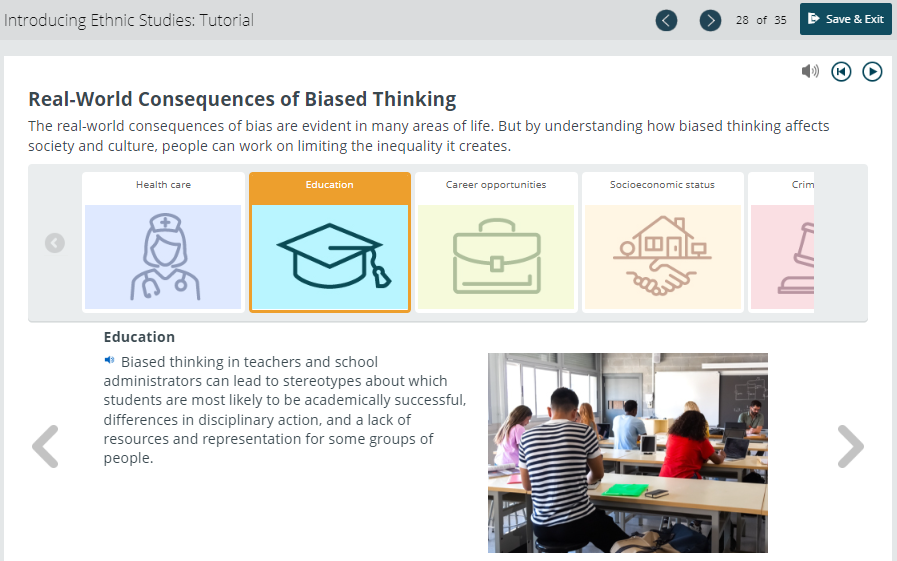
Figure 15a.

Figure 15b.
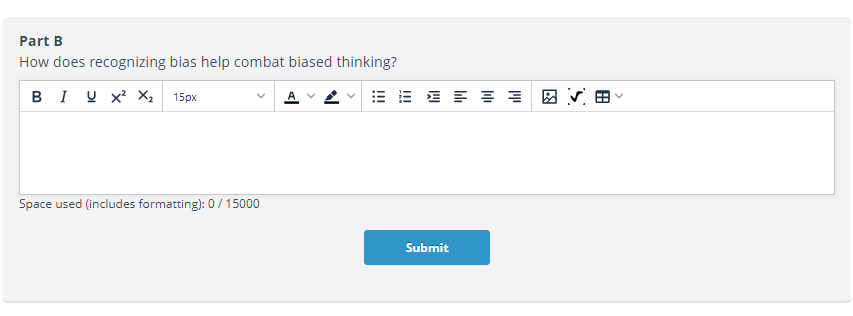
Figure 15c.
Figures 15a-c. In the first unit of the Ethnic Studies course, students learn about foundational concepts, including bias (a). That lesson ends by engaging in a self-checked opportunity for reflection about their understanding these concepts (b) as they make connections to what they learned about bias (c).

Figure 16. In the Guided Notes accompanying the Ethnic Studies course, students are asked to respond to what they have learned as they make personal connections to the material along their learning journey.
Edmentum Courseware also provides students with immediate feedback on formative checks for understanding. As this example from a Chemistry course shows, that feedback offers explanations for why an answer is correct to make the feedback more meaningful to learners.

Figure 17. When students select the correct answer in this formative assessment in a Chemistry tutorial, they receive a meaningful explanation for why that response answers the question. This same explanation also appears after two incorrect attempts at answering the question.
Lastly, Edmentum Courseware often includes discussions between students to help facilitate meaning-making. We see this in recent updates to our Mathematics courses.

Figure 18. After students in the Florida Algebra 1 course collect and model their own set of bivariate data about a topic of their choice, this activity asks them to present their model to peers and lead a discussion related to the data.

Figure 19. In a middle school Mathematics 6 course, students use an online discussion board to respond to prompts that ask them to apply what they learned and then choose a classmate’s problem to solve and explain their thinking.
5. Supporting Autonomy Positively Impacts Online Engagement
The need for emergency remote instruction brought about by the pandemic generated a great deal of research about online learning in recent years. One such study interviewed students and teachers to explore student engagement and found that online learning environments that support autonomy help engage students cognitively in self-regulated learning (Chiu, 2023).
How Edmentum Applies this Research to the Design of Courseware
Edmentum courses provide students autonomy and choice as they learn, helping them make personal connections to facilitate learning and increase engagement. We see this when students are given the autonomy to choose research topics of personal interest, as in this middle school Life Science animal research activity.

Figure 20a.
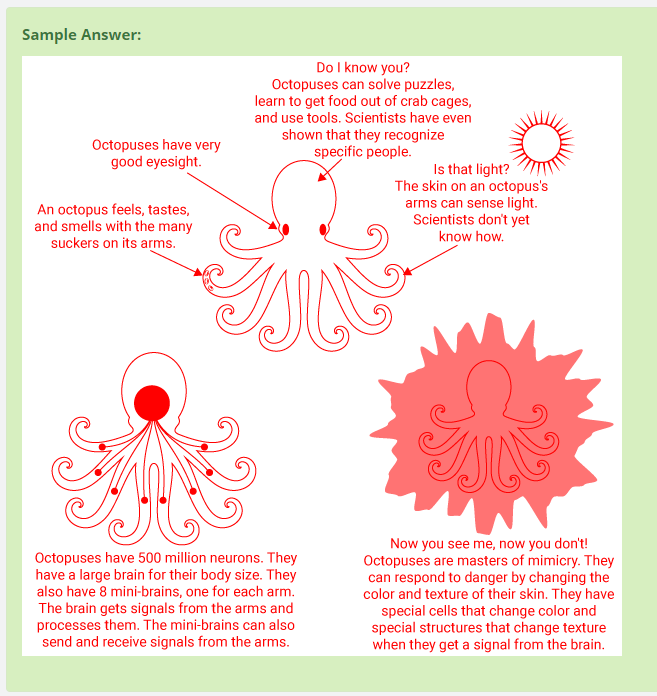
Figure 20b.
Figures 20a-b. In a Life Science course, middle school students learn about animals and then have the autonomy to apply what they learned with research about an animal of their choice (a). They then have a creative opportunity to display their research in an infographic, as this octopus sample answer in the course depicts (b).
Similarly, in the Career Explorations course that was recently released, students exercise autonomy as they determine career clusters of interest and learn more about how to enter specific careers of their choice.

Figure 21. The Career Explorations course ends Unit 1 with an activity that gives students the autonomy to explore careers of interest and to learn about the requirements are for entering each career pathway.

Figure 22. Students in this same Career Explorations course then research where in their state they might be able to pursue the education needed to enter their chosen pathways.
Looking Ahead
This article has shared examples that illuminate how Edmentum applies the latest academic research to set high expectations for students, to engage them in high quality learning acceleration, and to ensure that good learning design is embedded throughout our Courseware catalog to support their success. We will continue our ongoing review of research, updating our courses to maintain these commitments to innovation and excellence.
Visit our Courseware product page for additional information or get a quote.